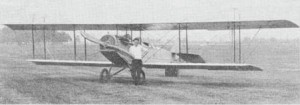Over six years after Wilbur Wright took to the sky in the Wright Flyer, sharing the air space with birds, Joseph “J.W.” Curzon in a Farman biplane “made a series of graceful flights” at the Indianapolis Motor Speedway on the afternoon of March 3, 1910, marking the first airplane flights ever given in Indianapolis. These flights were preliminary to the first licensed American aviation week held at the Speedway a few months later in June before curious crowds of onlookers. Over the next decade, the novelty of flight wore off as flying machines matured, and Indianapolis men joined the ranks of other aviators in the skies over France during the Great War.
Returning home, veteran U. S. Army aviators Leslie Sanders, John L. Wamsley, and Harold C. Brooks joined with Dr. John K. Kingsbury and John P. Koehler in organizing the Indianapolis Aerial Association in the early summer of 1920 to promote commercial aviation. The association leased a 22-acre flying field at Arlington Ave. and Twelfth St., and in addition to offering rides at $10 (2020: $132) per trip in its three-seater Avro and two-seater Curtiss Canuck, it staged air shows featuring wing walking, aerial acrobatics, and parachute leaps. Among those taking in one of the shows on a summer afternoon was Goodwin “Goody” Weaver, a young man from Irvington, and as luck would have it, the Avro made a poor landing and tore off the tail skid and smashed part of the wooden fuselage. Weaver, who was adept at woodworking and repairing engines, offered to fix the damage and soon had the plane back in flying shape. For his quick action, he was then offered, and accepted, the position of mechanic, with free flying lessons as a bonus, with the association.
“Goody” Weaver soloed in the Curtiss Canuck that summer and continued with the Indianapolis Aerial Association after it relocated to a flying field at Thirty-fifth St. and Emerson Ave. When fire destroyed the hangar and Avro, partially burning the Curtiss Canuck, in the fall of 1921, Weaver bought the damaged plane, rebuilt it, and with a second plane, launched Weaver Air Service the following spring. Also at this time, the Aero Club of Indianapolis was formally organized by “those interested in the development of aeronautics and the advancement of Indianapolis as an airplane manufacturing center.” The club leased a flying field on 110 acres along the north side of the National Road between Franklin and Post roads, and among its officers were Weaver’s Irvington neighbors John L. Wamsley and Harry E. Cross.
The bright turquoise blue painted Curtiss Canuck, the flagship of the Weaver Air Service, and one other plane flew from a pasture along Rawles Ave. between Arlington and Kitley avenues, not far from the home Weaver shared with his mother at 353 S. Audubon Rd. The flying field had no buildings, and the planes were protected with a tarp over the engines. For a tool house, Weaver simply used a nearby tree, “its branches adorned with tools, spare tires, oil cans and other accessories.” In addition to his commercial work, Weaver engaged in aerial photography. He taught his wife Esther Byrtene Cox Weaver to fly, making her the “only feminine aviator in town,” and she would “fly the machine” allowing Weaver to photograph.
Weaver generously flew his Curtiss Canuck across Indianapolis skies on promotional flights. On one of these early excursions as a member of the Aero Club, he was one of three intrepid pilots who, along with three intrepid flower droppers, were to “sail low over the corner stone laying ceremonies” for the new Athletic Club, at the southwest corner of Vermont and Meridian streets, and drop little boxes containing bouquets of fragrant blossoms, decorated with red, white, and blue ribbon, and attached to little white parachutes onto the site. Flying at 400 feet, the three planes dropped their flower laden bundles only to have “the playful breezes snatch them and carry them far away.” On other occasions accuracy was not required when chucking with “unerring aim” handbills carrying the slogan “Everybody Boost Greater Indianapolis” from his plane, and marking the opening of straw hat season by dropping fifty choice skimmers provided by the Harry Levison hat stores over the downtown area. Weaver’s low flying got on the nerves of some of his Irvington neighbors, and he was arrested in the summer of 1926 for violating a city ordinance.
He also flew humanitarian flights that included scanning the “hidden recesses of White River” between 16th St and College Ave. for two hours attempting to locate a missing man and flying a shipment of tetanus anti-toxin from Eli Lilly & Co. for tornado victims in Murphysboro and Carbondale, Illinois. After “bucking a choppy eighty-mile-an-hour wind for four hours,” Weaver was forced to land when he ran out of fuel just outside of Carbondale, compelling him to complete the delivery of the vital cargo to the Red Cross in the two towns by automobile.
Weaver was an aviation innovator and built and put in service a plane embodying “his own ideas in airplane construction.” With thick wings and steel fuselage that could accommodate two passengers and the pilot, it gave an “unusually sturdy appearance, though it [weighed] only 1,200 pounds,” and while carrying an eighty-horsepower engine it was capable of speeds of 90 mph. The airplane also had a split axle so it could take off and land safely in tall grass. After his marriage failed, “Goody” Weaver moved to California in 1927 and became a pilot for TWA. Known as “Ted” Weaver, he worked with aviation pioneer Charles Lindbergh surveying the airline’s transcontinental routes. He also had a role flying a German Fokker D.VII in the dogfight scenes in the Howard Hughes movie Hell’s Angels.



